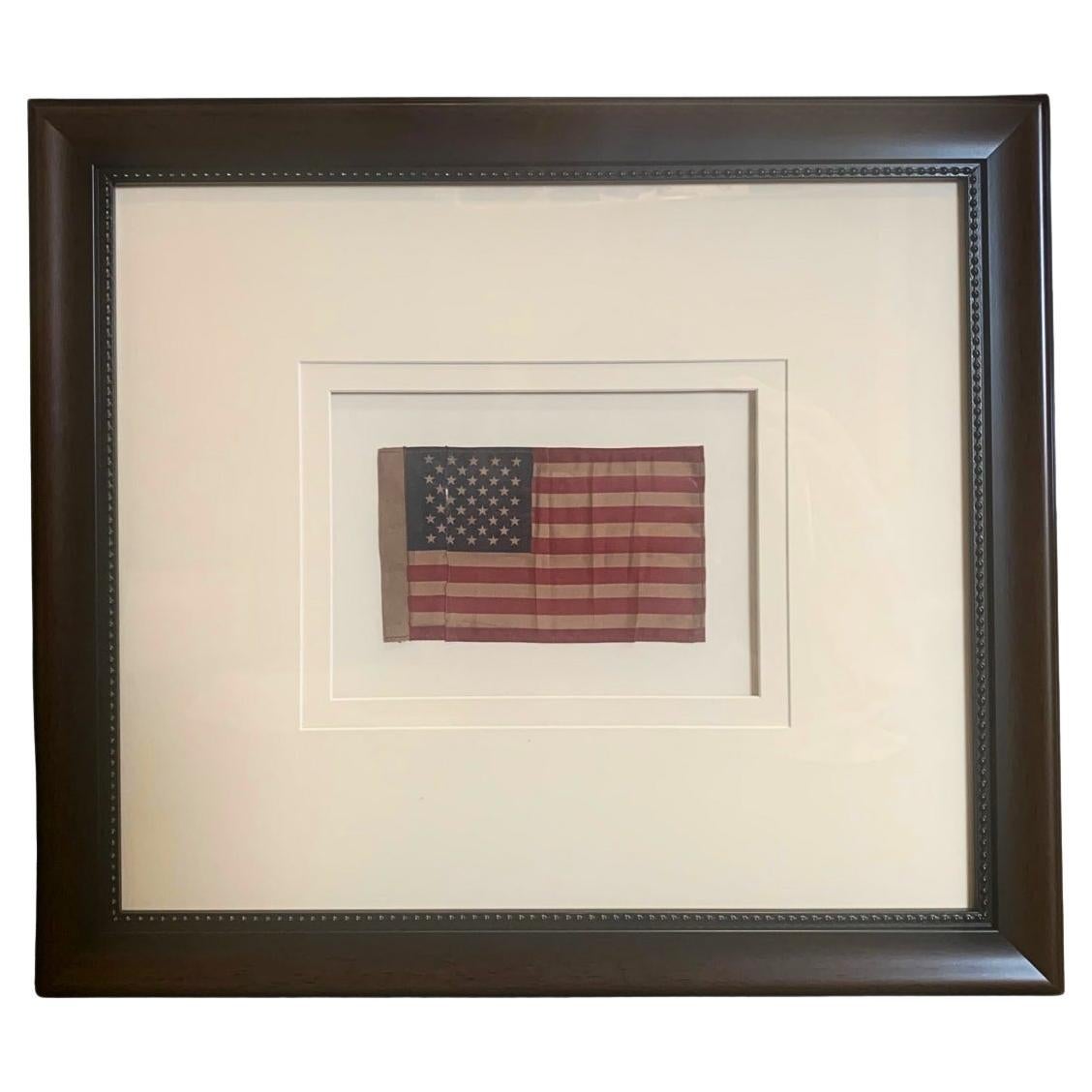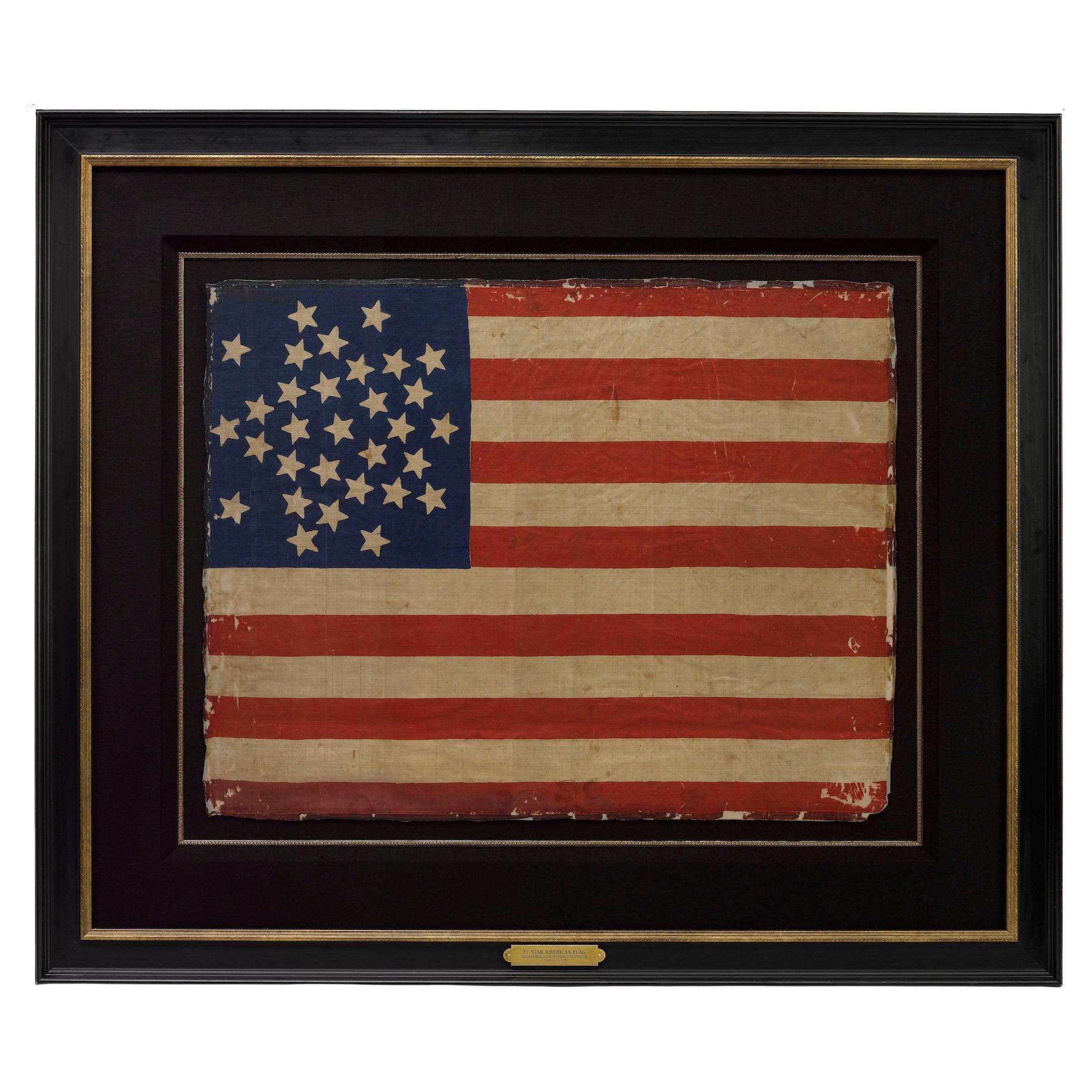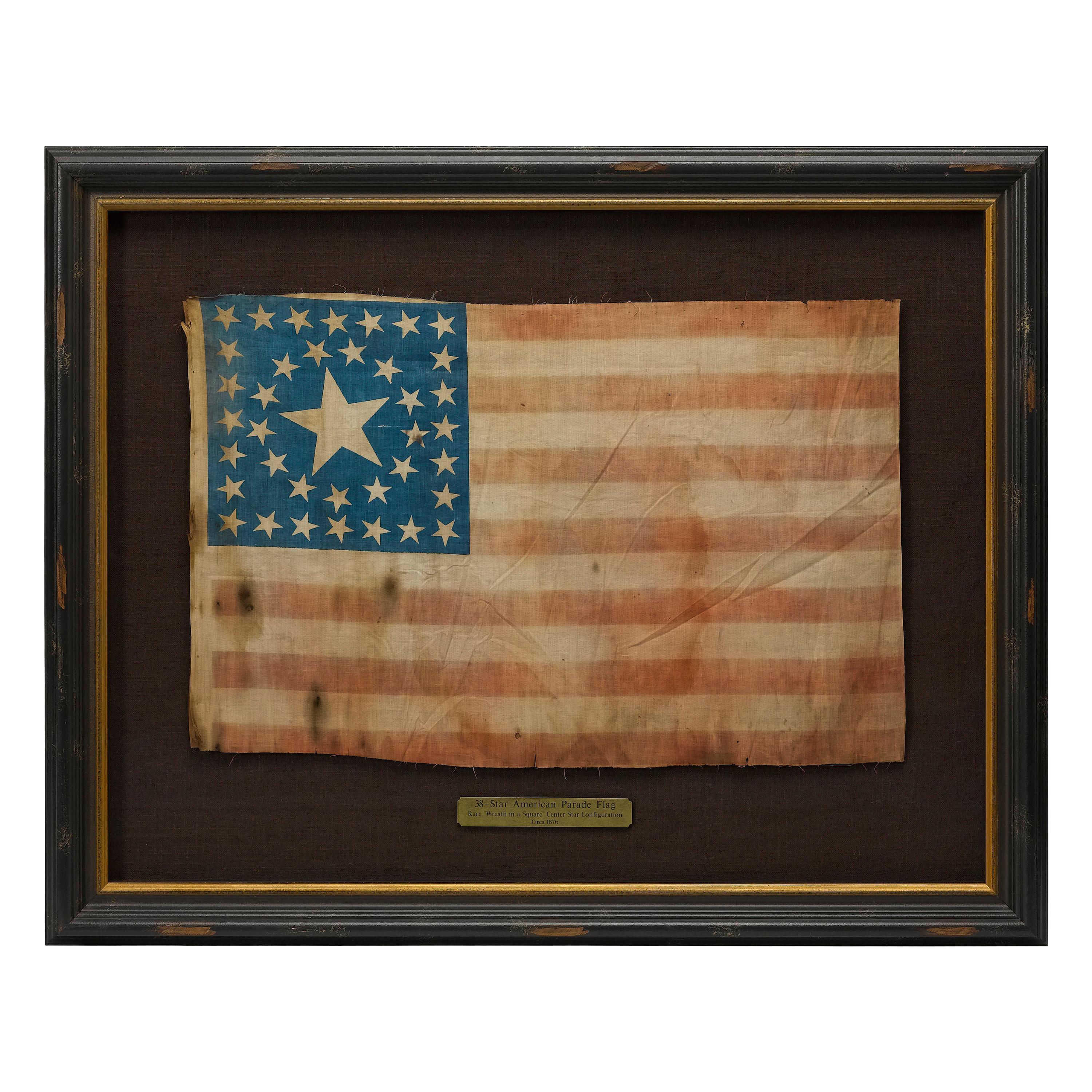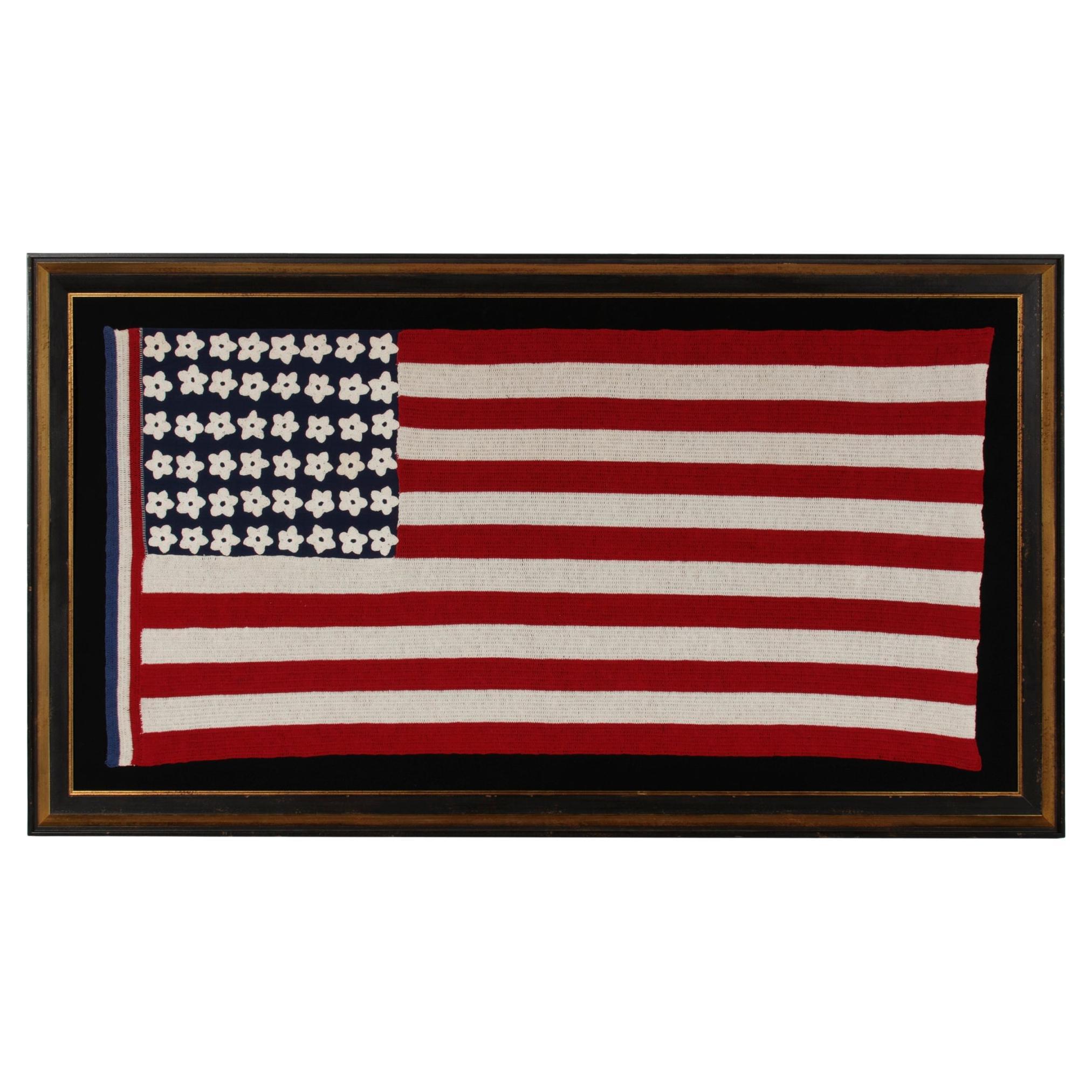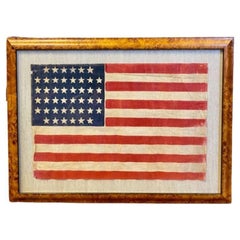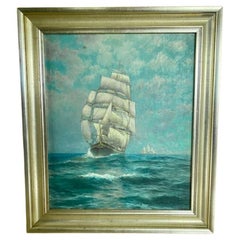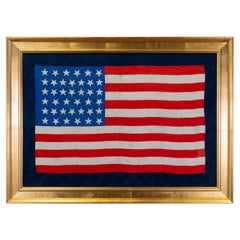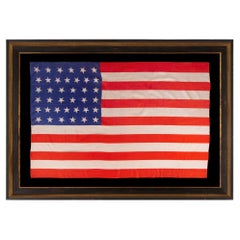
American 39 Star Flag, circa 1889
View Similar Items
Want more images or videos?
Request additional images or videos from the seller
1 of 6
American 39 Star Flag, circa 1889
About the Item
- Dimensions:Height: 18.25 in (46.36 cm)Width: 22.5 in (57.15 cm)Depth: 1 in (2.54 cm)
- Style:Other (Of the Period)
- Materials and Techniques:
- Place of Origin:
- Period:
- Date of Manufacture:circa 1889
- Condition:Wear consistent with age and use.
- Seller Location:Nantucket, MA
- Reference Number:Seller: AD - 275-00 ALV1stDibs: LU903928177812
About the Seller
5.0
Gold Seller
These expertly vetted sellers are highly rated and consistently exceed customer expectations.
1stDibs seller since 2010
243 sales on 1stDibs
Typical response time: 1 hour
More From This SellerView All
- American 44 Star Flag, circa 1891Located in Nantucket, MARare Antique American 44 Star Flag, circa 1891, marking admission of Wyoming as a state in 1891. This was an official flag of the United States for only five years, making it one of ...Category
Antique 1890s American Federal Historical Memorabilia
MaterialsMuslin
- American Darting Gun Toggle Iron Harpoon, Marked Macy, for Bark SunbeamLocated in Nantucket, MAAntique American Darting Gun Toggle Iron Harpoon, made by E.B. and F. Macy, New Bedford, for the Larboard Boat on the Whaling Bark Sunbeam (1856 - 1908), having an improved toggle head with acute barb (standing nearly at a right angle), and an unusual ridged cheek, with the maker's mark MACY stamped on the right cheek (the mark of E.B. & F. Macy, blacksmiths of New Bedford: 1861-1904), the ship stamp BK SB on the left cheek (for the Bark Sunbeam, and the dot punched boat mark L B (for the Larboard, or Second, or Port-side Stern whale boat); mounted on a round shank slightly kinked from use, ending in the spike end necessary for use with a darting gun, and the loop for splicing on the iron strap. An amazing artifact retaining a tremendous amount of historical documentation. The harpoon remain in very good condition with a still very sharp cutting edge and deep brown patina and no corrosion. The head is frozen, but in the absence of rust it would very likely free up with a little lubrication if so desired. The tip of the front barb has a small chip off tip. The slight kink to the shank comes from use and is considered by most to be a a good feature. The Bark SUNBEAM was built in Mattapoisett in 1856 and enjoyed a long career in the New Bedford whale fishery of 17 voyages to the Pacific, Atlantic and Indian Oceans. Clifford Ashley...Category
Antique 1860s American Other Nautical Objects
MaterialsSteel
- Seascape with Clippership by George Howell Gay (American: 1858 - 1931), ca 1890Located in Nantucket, MASeascape with Clippership by George Howell Gay (American: 1858 - 1931), circa 1890, an oil on canvas bow view of a clippership under full sail, running with stun'sls and skysails set, on lively sea under blue cloudy sky, with a second square-rigger visible in the background, signed in the lower right, and titled on the reverse "Clipper Ship Before the Wind." A beautiful and dramatic painting with a cool, brisk feel. The painting is in fine condition, with one small patch along the upper margin and a tiny spot of corresponding inpainting. Measures:24 in H x 20 in W Framed: 29 in H x 25 in W George Howell Gay was born in Milwaukee, Wisconsin, and educated in Chicago under Paul Brown and Henry Elkins, and in 1889 moved to Bronxville, New York. He worked in all media, but was especially fond of watercolor, which allowed him to capture the transparency of the ocean and the luminous qualities of sunlight and clouds. Gay worked along the Northeastern coast from Rhode Island to Maine, but also painted summer and winter landscapes throughout New England. Gay’s seascapes were exhibited at the Boston Art...Category
Antique 1890s American Other Paintings
MaterialsCanvas
- Antique American Pond ModelLocated in Nantucket, MAAntique American Marconi-rigged sloop Pond model with planked deck, double spreaders and full running rigging.Category
Early 20th Century American Models and Miniatures
MaterialsBrass
- Nantucket Opera House Menu, circa 1960s to 1970sLocated in Nantucket, MARare Vintage Menu from the Opera House Restaurant on Nantucket, circa 1960s. The beloved and fondly missed Opera House was the iconic restaurant owned and operated by Gwen Gaillard o...Category
Vintage 1960s American Other Historical Memorabilia
MaterialsPaper
- Grand Banks Dory Fishermen Seascape by Joseph Woods, circa 1910Located in Nantucket, MAAntique grand banks dory fishermen seascape by Joseph A. Woods, circa 1910, an impressionist oil on panel seascape with two fishermen in dory in the foreground hauling back on their ...Category
Vintage 1910s American Other Paintings
MaterialsWood
You May Also Like
- 39-Star Antique American Flag with 'Whimsical' Star Pattern, 1889Located in Colorado Springs, COThis is a 39-star unofficial American flag, handmade and printed on cotton. The flag dates to 1889 and has a unique history, thanks to its rare star-count. The flag’s canton is prin...Category
Antique 1880s American Political and Patriotic Memorabilia
MaterialsCotton
- 1889 North Dakota 39 Star United States of America Statehood FlagLocated in Coeur d'Alene, ID39 star silk statehood flag. 23 1/2" x 15". Was the unofficial North Dakota Flag. As South Dakota was also admitted as the 40th state on the same day this...Category
Antique 1880s American Historical Memorabilia
MaterialsSilk
- 38 Star Antique American Flag, Colorado Statehood, ca 1876-1889Located in York County, PA38 star antique American parade flag with scattered star orientation, made of silk, with generous scale and vivid colors, Colorado Statehood, 1876-1889 38 star American national p...Category
Antique Late 19th Century American Political and Patriotic Memorabilia
MaterialsSilk
Price Upon Request - 38 Star American Flag, Stars in Notched Pattern, ca 1876-1889Located in York County, PA38 HAND-SEWN STARS IN A "NOTCHED" PATTERN, ON AN ANTIQUE AMERICAN FLAG WITH BEAUTIFUL WEAR FROM HAVING BEEN EXTENSIVELY FLOWN, MADE AT THE TIME WHEN COLORADO WAS THE MOST RECENT STATE TO JOIN THE UNION, 1876-1889 38 star Antique American flag, made during the period when Colorado was the most recent state to join the Union. The stars are arranged in what is known as a "notched" pattern, in which two spaces were left open along the hoist end, in the first and last rows, in anticipation that two more Western Territories would soon join the Union. The latter 19th century was a time of when much of the land in and about the Continental Divide was formalized into states, and there was continual speculation about which ones would be accepted next, and with what boundaries. The stars of the flag are made of cotton and are double-appliquéd (applied to both sides) with a lineal, treadle stitch. The canton and stripes of the flag are made of wool bunting that has been pieced with treadle stitching. The canton was constructed from five separate lengths of fabric, which is an unusual feature, though hardly unknown. To each of these a row of stars was sewn. This manner of construction is sometimes encountered and tends to be an early trait, at least when it occurs in flags of this scale and smaller. When encountered, it also seems to have been preferred in flags meant for maritime use. While the feature does not by any means guarantee this fact, it is a reasonable, educated guess, based upon my examination of many other examples. A flag with a 5-piece canton, such as this, would have been less likelihood to stretch, with increased structural integrity. The alternative is that this was simply an example made when there were at least five pieces of leftover fabric, of a reasonable size to made individual rows, and that what it actually demonstrates is the careful conservation of scarce resources. There is a sailcloth canvas binding along the hoist, with 3 brass grommets, evenly spaced. Perhaps the best feature of the flag is the evidence it displays of having been extensively flown, with the fly end whipped out from wind exposure. While many flags display damage from a combination of having been flown, exposure to the elements, various mishaps, and improper storage, very few exhibit wear such as this, which is both endearingly and visually attractive. This one shows its age beautifully, whipped out along the fly end, with losses that convey an element of movement, that most flags don’t capture in the state in which they survive. Colorado became the 38th state on August 1st, 1876. This was the year of our nation’s 100-year anniversary of independence. Per the Third Flag Act of 1818, stars were not officially added until the 4th of July following a state's addition. For this reason, 37 was the official star count for the American flag in 1876. Flag-making was a competitive venture, however, and few flag-makers would have been continuing to produce 37 star flags, when their competitors were making 38’s. It is for this reason that 38 and 13 stars (to represent the original 13 colonies...Category
Antique Late 19th Century American Political and Patriotic Memorabilia
MaterialsWool
Price Upon Request - 41-Star Printed Flag Waver, Celebrating Montana Statehood, 1889Located in Colorado Springs, COPresented is a very rare, 41-star flag waver celebrating Montana statehood. The flag is printed on linen and dates to 1889. The dark blue canton is printed with forty one stars in nine rows of alternating counts of five and four stars. Thirteen red and white stripes complete the flag’s design. The history of Montana statehood is a long one. Numerous Native American tribes originally inhabited the Montana Territory. Meriwether Lewis, William Clark, and the members of their expedition were the first explorers to document a journey through Montana and the lands of the Louisiana Purchase. Soon, forts were established to facilitate regular fur trading with Native American tribes. Missionaries and trailblazers followed. The discovery of gold in the early 1860s sped the creation of the Montana Territory. As settlers and gold prospectors entered Montana in the 1860s and 1870s, conflicts with the Native Americans arose. Perhaps the most famous clash between Native Americans and the United States military occurred in Montana on June 25, 1876. On that day, Sioux and Cheyenne defeated Lieutenant Colonel George Armstrong Custer‘s 7th United States Cavalry regiment at the Battle of the Little Bighorn. A year later, Nez Percé Chief Joseph surrendered in the Bear Paw Mountains of Montana. Lured by copper in the 1880s, mining brought even more settlers to Montana. Rich grazing lands for cattle and sheep attracted other pioneers. Each of the states in America, with the exception of the original thirteen, Texas, and California, was first organized as a territory before achieving admittance to the Union as a state. Originating with the Ordinances of 1785 and 1787, the territorial system provided the expanding U.S. with a method to govern frontier areas until they gained sufficient population and economic maturity to qualify for statehood. Not surprisingly, residents of frontier territories usually demanded quick admission to statehood so they could gain full control of their local governments. Montana was a territory for 25 years – from the creation of Montana Territory in 1864 until the territory was admitted to statehood in 1889. On November 2, 1889, North and South Dakota were added to the Union as the 39th and 40th states, the first time in history that two states were admitted on the same day. Montana became the 41st state on November 8, predating Washington, the 42nd state, by only three days. Flag makers were not in the business of making out-of-date flags. As a result of these rapid changes in the number of states, only a small number of 41-star flags or commemorative items were ever produced, thereby making any 41-star flag exceedingly rare. CONDITION: Good condition. This flag is printed, with a hemmed headband and fly end in a running stitch...Category
Antique 1880s American Political and Patriotic Memorabilia
MaterialsLinen
- 34 Star American flag, Updated to 39 Stars, with Stars in a Great Star PatternLocated in York County, PA34 STARS IN A WHIMSICAL RENDITION OF THE GREAT STAR PATTERN, ON A CIVIL WAR PERIOD FLAG WITH A CORNFLOWER BLUE CANTON, UPDATED TO 39 STARS IN 1876 34 star American national flag with additional stars added and one of the most stunning graphic designs I have ever seen in early flag-making. The original pattern was comprised of a circle of 5 large stars, and triangular arms made of smaller stars. These are noticeable pointy and bent like the arms of a starfish. Made of cotton, the stars are hand-sewn and double-appliquéd to a fantastic, cornflower blue canton, a color common to Civil War uniforms...Category
Antique 1870s American Political and Patriotic Memorabilia
MaterialsCotton
Recently Viewed
View AllMore Ways To Browse
Silk Flags
1889 Flag
Antique Flags Historical Memorabilia
Antique Flag Historical Memorabilia
39 Star Flag
39 Star American Flag
Tiger On Silk
Antique Tiger Maple Furniture
Antique Tiger Maple
Tiger Maple Frame
Star Tiger
Vintage German Christmas
Christmas German
British Coat Of Arms
Antique And Vintage Woods Of America
Authentic Flags
Antique Rare Coins
Antique And Rare Coins




